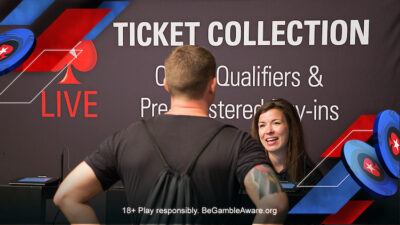Poker is a game of limited information, so any info you can access — particularly from your own experiences playing against an opponent — is incredibly valuable.
So if you’re not already colour-tagging players on PokerStars and using the note-taking feature, you’re missing a trick.
Here, we’re going to look at why labelling and note-taking can be so beneficial and how you can start doing it today, kicking off with an example from arguably the best poker film of all time.
SPOILER ALERT: This article contains Rounders spoilers. But c’mon, the film came out in 1998. You’ve had 22 years. If you’re a poker fan and you haven’t watched Rounders, we suggest you do so.
When Mike McDermott checks his nut straight to Teddy KGB all the way to the river in Rounders, knowing full well that the “Mad Russian” will blast off for his entire stack holding an inferior hand, it wasn’t down to McDermott’s pure intuition.
Earlier in the film, we see McDermott watching Johnny Chan’s infamous 1988 World Series of Poker final hand, in which he too checks the nut straight three times to his heads-up opponent, Erik Seidel.
“He knows Seidel is going to bluff at it,” says Petra, who works at the Chesterfield poker club. “He knows his man well enough to check it all the way, and risk winning nothing with those cards.”
Like Chan, Mike McD knows his man.
Having played against KGB before, McDermott clearly has him mentally tagged as a certain type of player. Not only that, but he has also made mental notes on prior hands they’ve played together (Oreo-based notes, predominantly).
So, what did McDermott know about Teddy KGB?
♥ Well, for one, he knows that KGB isn’t a professional poker player. Teddy is the owner/operator of his own poker club and has some arguably shady business dealings on the side, so he could be tagged as a recreational player with deep pockets.
♦ He also knows that KGB is capable of slow-playing a big hand. In the opening scene of Rounders we see him just call with pocket aces from the big blind, check-call an overbet when he flops top set, check again when he turns a full house, then lead out on a blank river for value.
♣ He also knows that KGB is willing to bet and stack off light with some weak one-pair type hands, as we see him do so during their heads-up battle.
♠ And he knows that when KGB eats his Oreo, he always has a strong hand. At the beginning of the film, McDermott unknowingly observes KGB eat his Oreo after breaking it. He then shows up with a winning full house. Later, he sees KGB break his cookie but not eat it before folding a weak hand.
Oh, and we know that he likes to splash the pot. Because in his club, he can splash the pot whenever he pleases.
This information is pivotal to McDermott’s victory.
**********
HOW TO TAG PLAYERS ONLINE
While McDermott has to rely on his memory, PokerStars gives players the ability to tag each opponent a certain colour in-game.
If you’ve ever watched a poker streamer on Twitch, you’ll have noticed these colour tags. Take Lex Veldhuis, for example; a man so passionate about tagging players that he offers up prizes to viewers should he ever come across a tournament lobby where he has every single player already tagged.
You’ll notice he has every player at the table tagged a different colour. These colours represent different ability levels, playing styles, and more. Check out Lex’s tags below:


Lex’s labels
At the very least these tags let Lex know he has played against this opponent before. This is very useful when you’re multi-tabling, as you won’t have to waste time looking them up*.
You’ll decide which colour to tag a player based on the information you have. This could be based on a crazy hand you just watched them play.


You’ll notice Lex has every player at his tables tagged and often has notes on them too
For example, if they open-shoved for 50 big blinds under the gun with J♠ 2♦ , you might want to tag them as wild and crazy. Alternatively, if you see them fold K♦ K♠ face-up to a three-bet shove, you’ll probably want them tagged as a super-tight player who can be pushed around.
It could also be based on their skill level. Lex uses different shades of green for good regulars and legends, while he uses red for recreational players, whom he refers to as “fun players” (ie. players who are not professionals and only play poker for fun).
So, the first thing you’ll need to do is create your own labels and assign a colour to each of them.
If you’re a beginner, you’ll want to keep these simple. Tagging other players as “fun players” when you’re new to the game yourself would be like the pot calling the kettle black.
Instead, perhaps focus on their style of play. Maybe use orange for crazy players, blue for very tight players, yellow for loose-aggressive players, red for very good players, etc.
To assign a label to a player, simply right click on the player and go to Label. Then choose the label you want them to be. Their avatar will then be circled in that colour, and the colour will show up next to their name in a tournament lobby*.
*How do you look up a player?
That depends how informed an opinion you require.
If you want to know whether they are a profitable player and how often they play, you’ll need to use a third-party tracking website like Sharkscope or PocketFives.
However, if you just want to see what other tournaments they are playing at that time in order to gauge their average buy-in level, you can hit ‘Command+F’ and search for their screen name.
Alternatively, go to the PokerStars client, click on Tools, then Find, then A Player, and search for the screen name there.
*Why is it useful to see colour tags in a tournament lobby?
Seeing tags in a lobby is very useful as it will show you how hard or difficult a tournament field might be.
For instance, if all you see are players you’ve tagged as beasts, you might not want to sit down. Alternatively, if the field is full of players you’ve tagged as weak, then hop right in.
HOW TO TAKE NOTES ON A PLAYER ONLINE
PokerStars also allows you to take written notes on players in-game, whenever you see something worth remembering (Oreo-based or not).
Let’s use the example I gave you earlier of a player folding K♦ K♠ face-up to a three-bet shove.
This is definitely something you’ll want to make a note of. If you then find yourself sat on a table with this player a few months down the line, you can check your note and see that this is a player you should be three-betting a lot.
A note might look something like this:
“They 2x opened from the cutoff off of 40bbs, I 3-bet jammed 12bbs from the bb, they tank-folded and showed KK. PLAY AGGRESSIVE AGAINST THIS OPPONENT.”
Or:
“Have seen them open hands like Q2off, 73off, and K4off from early position. PLAY LOOSER RANGE AGAINST THIS OPPONENT.”
Or:
“All night he check check check check. He trap me!”
Just kidding about that last one.
But how do you make a note in-game?
Simply right-click on the player and click on Note. This is will open the note-taking window in the bottom left corner of your table. You can type in your note here, and it will be permanently stored with the player.
You’ll know whether or not you have a note on a player as there will now be an ‘N’ symbol on the player’s avatar. To read it, right-click on them, click Note, and your note will appear in the bottom left.
Best of luck tagging and taking notes from here on out.
Soon your opponents will have no choice but to take a note on you:
“They beat me. Straight up. Pay them. Pay that person their money.”







